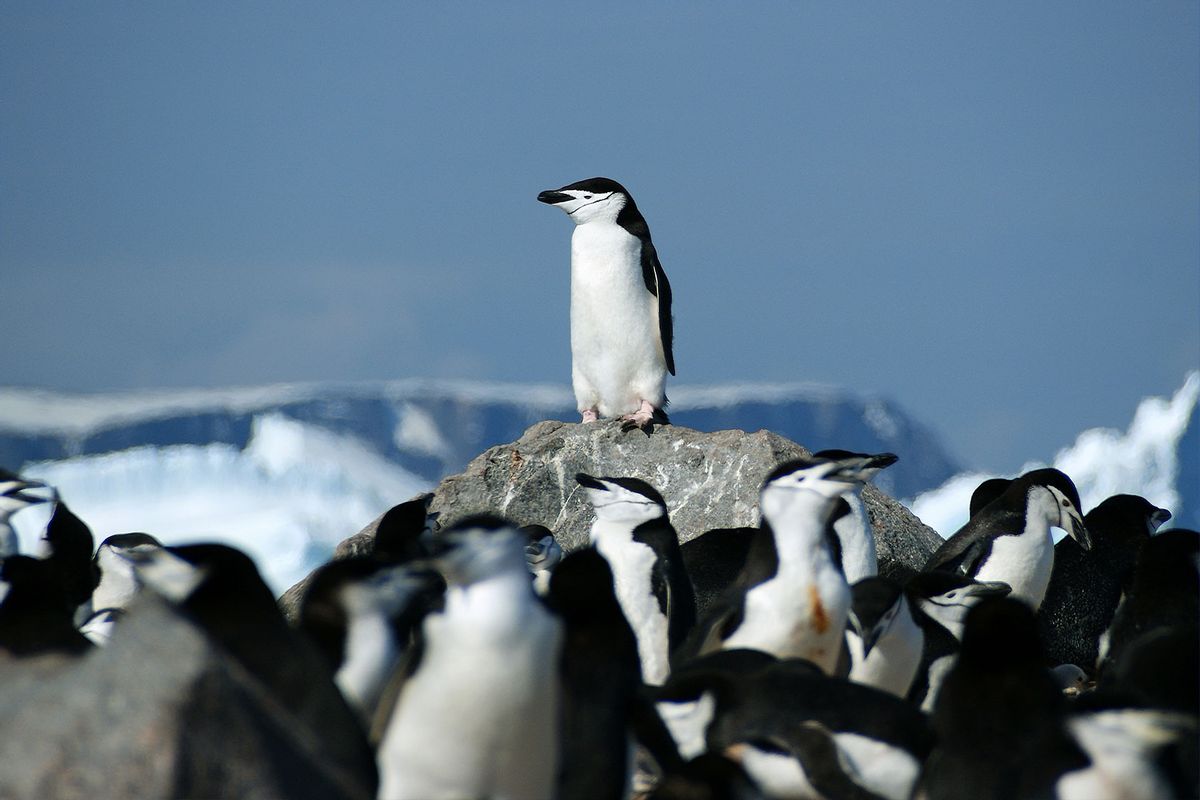"The investment in microsleeps by successfully breeding penguins suggests that the benefits of sleep can accrue incrementally."
Nearly all animals need some form of sleep to survive, but not all of them sleep in the same ways as humans. Take chinstrap penguins (Pygoscelis antarcticus), the adorable two-foot-plus waddling birds named for the distinctive and dignified black stripes at the bottoms of their heads, which are indigenous to the islands and shores of the Southern Pacific and Antarctic Oceans.
Now a new study in the journal Science reveals that chinstrap penguins have a very unique way of sleeping. Instead of getting six-to-eight hours at night like humans, chinstrap penguins sleep thousands of times per day in four second spurts — but accumulate a daily 11 hours of sleep in the process.
Researchers from France, Germany and South Korea learned this by studying 14 chinstrap penguins sleep patterns with an electroencephalograph, which measures brain activity. While the chinstrap penguins swam in the ocean or nested on King George Island, which is near Antarctica, they regularly faced threats such as aggression from other penguins or predatory birds like the brown skua pursuing their eggs. As a result, sleeping for lengthy periods can be risky, so they evolved an ability to enter rest states in spurts of up to four seconds. This results in chinstrap penguins sleeping more than 10,000 times each day. As the authors concluded, "The investment in microsleeps by successfully breeding penguins suggests that the benefits of sleep can accrue incrementally."
Of course, just because the scientists proved that the penguins achieved some level of sleep during those four second bursts, the exact quality of the sleep is another matter entirely. It is entirely possible that the chinstrap penguins pay for their so-called "microsleeps" by not being fully restored when they wake up — just like humans who experience dementia-like cognitive ability when too sleep deprived.
"Although we did not directly measure the restorative value of microsleeps, the chinstrap penguins’ large investment in microsleeps, characterized by potentially costly momentary lapses in visual vigilance (eye closure), and their ability to successfully breed, despite sleeping in this highly fragmented manner, suggest that microsleeps can fulfill at least some of the restorative functions of sleep," the researchers wrote. They theorized that even though the neuronal silence only lasts for a few moments, each period could provide enough of a window for rest and recovery that the advantages "could accumulate irrespective of the duration of SWS bouts." This comes with many benefits, including that it "may give animals the flexibility to partition sleep into short or long bouts, depending on their ecological demands for vigilance."
Want more health and science stories in your inbox? Subscribe to Salon's weekly newsletter Lab Notes.
"The acquisition of SWS primarily through thousands of microsleeps lasting only 4 [seconds] is unprecedented, even among penguins."
The next question that one might have is whether chinstrap penguins are unique in this regard. Are there other birds that might acquire slow-wave sleep (SWS), the most restorative type of sleep, through this unusual method?
The authors report that bouts of avian SWS are known to be short compared to the same process in mammals, but write "thousands of microsleeps lasting only 4 [seconds] is unprecedented, even among penguins."
Non-breeding emperor penguins held in captivity do frequently alternate between waking and short-wave sleep patterns in a state called "drowsiness" that resemble the microsleep patterns observed in chinstrap penguins. There is a significant difference, though, between the two: those penguins only spent 14% of their time while drowsy, and spent another 37.5% of their time in their own version of SWS. Likewise the New Zealand species known as little penguins (Eudyptula minor) show similar bursts of slow waves when in a state of so-called "quiet wakefulness" that is similar to micro sleep in chinstrap penguins. Yet those birds' spurts of SWS on average lasted more than ten times as long at 42 seconds.
"The difference between sleep continuity in these penguins and chinstrap penguins is likely related to the recording context (captive and alone as opposed to wild in a colony) and the birds’ reproductive state," the authors speculated.
Sleep is vital to good health for humans. When humans lack quality sleep because of common medical conditions like apnea, or because they are overworked at home or their jobs, their bodies and minds pay a steep price. Although humans would be ill-advised to try getting all of their sleep in four-second bursts, that does not mean humans cannot benefit from getting rest in unexpected places. For instance, there is growing evidence that napping in the middle of the day provides health benefits.



Shares